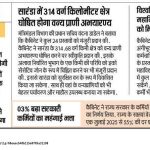LWE Naxal affected districts have witnessed an unprecedented decline in 2025, marking India’s biggest victory in the fight against Left Wing Extremism. The number of LWE Naxal affected districts has dropped to a historic low of just 38 districts across the country – a remarkable achievement that reflects years of strategic planning, development initiatives, and security operations.
🇮🇳 India’s Landmark Victory Against Left Wing Extremism
In a remarkable achievement for India’s internal security, the number of LWE (Left Wing Extremism)/Naxal affected districts has dropped to just 38 – the lowest figure ever recorded in the country’s history. This significant milestone reflects the government’s comprehensive approach to tackling Naxalism through security, development, and governance initiatives implemented by the Ministry of Home Affairs.
📊 The Numbers Tell the Success Story
| Year | Number of Affected Districts | Reduction |
|---|---|---|
| 2013 | 106 | — |
| 2025 | 38 | 64% Reduction |
Key Highlight:
This represents a phenomenal 64% reduction in LWE/Naxal affected districts, dropping from 106 in 2013 to just 38 today!
🗺️ Understanding LWE Naxal Affected Districts
The term LWE Naxal affected districts refers to geographical areas where Left Wing Extremist groups, commonly known as Naxalites or Maoists, have been active. These districts have historically faced challenges including violence, underdevelopment, poor infrastructure, and limited access to government services. The reduction in LWE Naxal affected districts from 106 to 38 represents not just a security achievement but also successful socio-economic transformation.
📍 Which States Had LWE Naxal Affected Districts?
The LWE Naxal affected districts were spread across multiple states including:
- Chhattisgarh – Previously the most affected state
- Jharkhand – Significant reduction in affected areas
- Odisha – Major improvement in tribal belts
- Maharashtra – Gadchiroli and adjoining regions
- Madhya Pradesh – Balaghat and Bastar regions
- Telangana – Border districts with Chhattisgarh
- Bihar – Gaya and adjoining areas
- Andhra Pradesh – Northern tribal districts
- West Bengal – Junglemahal region
✅ Key Achievements & Impact
🔹 Security Improvements
- Drastic decline in violence: Naxal-related incidents have decreased significantly
- Reduced casualties: Both security forces and civilian casualties are at historic lows
- Enhanced operational capacity: Better coordination between central and state forces
- Improved intelligence: Better tracking and neutralization of extremist activities
🔹 Development Initiatives
- Road connectivity: Remote areas now connected through strategic road networks
- Mobile connectivity: 4G towers installed in previously isolated regions
- Banking services: Financial inclusion through bank branches and ATMs
- Educational facilities: New schools and skill development centers established
🔹 Governance Reforms
- District administration strengthened in affected areas
- Welfare schemes implementation improved
- Local self-governance empowered through Panchayati Raj institutions
Learn more about governance reforms and latest news updates on our website.
🎯 Government’s Multi-Pronged Strategy
The government’s approach has been holistic, focusing on three key pillars:
🛡️ Security
Modernization of security forces, better intelligence networks, and coordinated operations between CRPF and state police forces
🏗️ Development
Infrastructure development, livelihood opportunities, and social welfare schemes under various government initiatives
⚖️ Rights & Entitlements
Ensuring constitutional rights reach every citizen, focus on tribal welfare and forest rights
💪 Benefits to Local Communities
The reduction in affected districts means:
- ✅ Safer lives for millions of tribal and rural populations
- ✅ Better education opportunities for children
- ✅ Healthcare access through new medical facilities
- ✅ Economic growth through mining, industries, and agriculture
- ✅ Employment opportunities in previously affected regions
- ✅ Women empowerment through self-help groups and skill training
🚀 The Way Forward
While this achievement is commendable, the government remains committed to completely eliminating Left Wing Extremism from India. Continued focus on:
- Sustained development in the remaining 38 affected districts
- Rehabilitation programs for surrendered Naxals
- Youth engagement through education and employment
- Strengthening local governance structures
- Protecting tribal rights and preserving their culture
💡 Did You Know?
The affected districts span across states including Chhattisgarh, Jharkhand, Odisha, Maharashtra, Madhya Pradesh, Telangana, Bihar, Andhra Pradesh, and West Bengal.
📢 Call to Action
Join the conversation! 💬 What are your thoughts on this historic achievement? How do you think this will impact the development of tribal areas? Share your views in the comments below! 👇
🔔 Stay Updated!
Don’t miss important updates on India’s development and governance initiatives!
Subscribe to our newsletter | Follow us on social media | Share this article
Source: Press Information Bureau, Government of India
Reference: PIB Press Release


